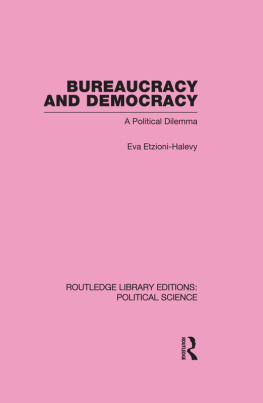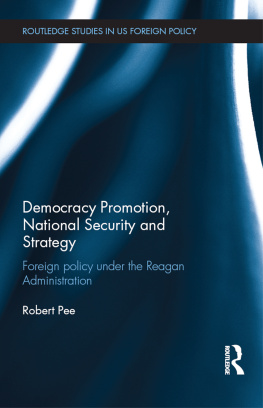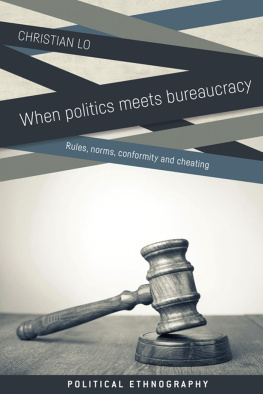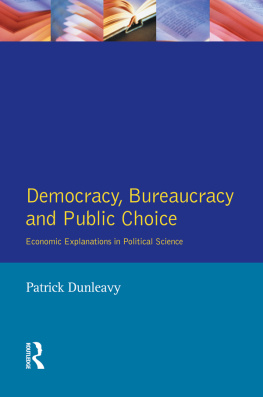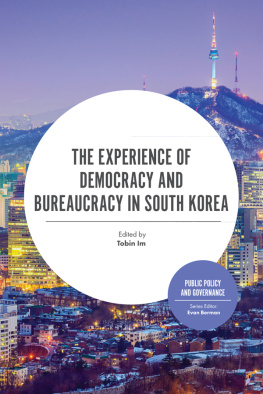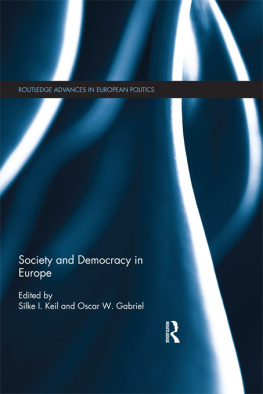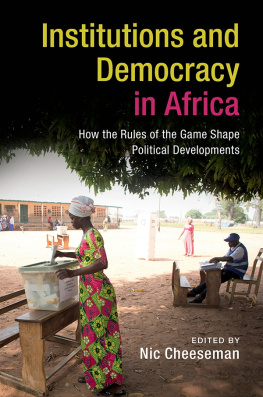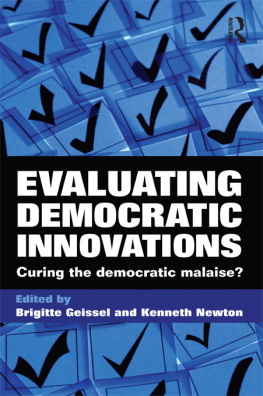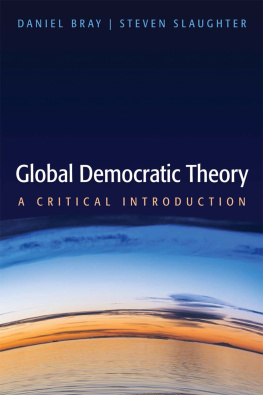First published 1983
Revised edition 1985
This edition first published in 2010
by Routledge
2 Park Square, Milton Park, Abingdon, Oxon, OX14 4RN
Simultaneously published in the USA and Canada
by Routledge
270 Madison Avenue, New York, NY 10016
Routledge is an imprint of the Taylor & Francis Group, an informa business
1983, 1985 Eva Etzioni-Halevy
All rights reserved. No part of this book may be reprinted or reproduced or utilised in any form or by any electronic, mechanical, or other means, now known or hereafter invented, including photocopying and recording, or in any information storage or retrieval system, without permission in writing from the publishers.
British Library Cataloguing in Publication Data
A catalogue record for this book is available from the British Library
ISBN 10: 0-415-49111-8 (Set)
ISBN 13: 978-0-415-49111-2 (Set)
ISBN 10: 0-415-55537-X (Volume 7)
ISBN 13: 978-0-415-55537-1 (Volume 7)
Publishers Note
The publisher has gone to great lengths to ensure the quality of this reprint but points out that some imperfections in the original copies may be apparent.
Disclaimer
The publisher has made every effort to trace copyright holders and would welcome correspondence from those they have been unable to trace.
Bureaucracy and democracy
A political dilemma
Eva Etzioni-Halevy
Revised edition
First published in 1983
Revised and first published as a paperback in 1985
by Routledge & Kegan Paul plc
14 Leicester Square, London WC2H 7PH,
9 Park Street, Boston, Mass. 02108, USA,
464 St Kilda Road,
Melbourne, Victoria 3004, Australia, and
Broadway House, Newtown Road,
Henley-on-Thames, Oxon RG9 1EN
Eva Etzioni-Halevy 1983, 1985
No part of this book may be reproduced in any form without permission from the publisher, except for the quotation of brief passages in criticism
Library of Congress Cataloging in Publication Data
Etzioni-Halevy, Eva.
Bureaucracy and democracy.
Bibliography: p.
Includes index.
1. Bureaucracy. 2. Democracy. I. Title.
JF1411.E891983306.283-9498
ISBN 0-7100-9573-2 (c)
ISBN-07102-0053-6 (p)
Preface
This book presents a general overview of the relationship between bureaucracy and the politics of democracy intended primarily for students of sociology, political science and public administration. It is designed to help guide students as painlessly as possible through the maze of classical and modern theories on this topic, to give them some basic information on the historical developments in this area, and to present them with case studies on the actual relationship between bureaucrats and politicians in democratic societies.
While it is an overview, the book also presents my own views. I therefore hope that it may be worth a glimpse by scholars in the field as well, if only for the purpose of stimulating some of the critique and controversy on which the social sciences so evidently thrive. I further hope that journalists, bureaucrats and members of the general public who take an interest in bureaucracy may also find it helpful.
The intent to reach such a diverse audience entails a diversity of obligations. A well-known observer of bureaucracy, Brian Chapman (1961, p. 20), once wrote: Bureaucracy is like sin: we all know something about it, but only those who practise it enjoy it. In this book I hope to fulfil some of the obligations towards the audience by showing that not only the practice but also the study of bureaucracy can be enjoyable. Or at least, that it need not be unenjoyable.
In the first place, I have set myself the task of showing that the study of bureaucracy need not be unduly difficult. To this purpose I have made special efforts to minimize professional jargon and to express all ideas as simply and concisely as possible. I have worked on the assumption that ideas that cannot be expressed clearly are themselves muddled and therefore are not worth expressing at all.
Secondly, I have set myself the task of showing that the study of bureaucracy need not be confusing. It has been claimed that theories of organization are in a state of disarray ; that, in fact, organization theory is rather like a flying saucer never seen in the same place twice (Parker et al. 1972, p. 89). In this book, which deals with state bureaucracy only, I hope to show that, in that more limited area at least, it is possible to introduce into the multitude of theories a certain pleasing order.
Finally, I have set myself the task of showing that the study of bureaucracy need not be tedious. The common image of bureaucracy may well be one of uncommon boredom. But in this book I hope to show that reality is quite different: that indeed the relations among bureaucrats themselves and between bureaucrats and politicians are rather intriguing, and therefore that case studies illustrating such relations will be quite colourful.
I can only conclude with the well-worn but ever-applicable phrase that it must be left to the reader to decide to what extent I have been successful.
Acknowledgments
The work of the social sciences thrives on critique and controversy, and this book is no exception. It has profited greatly from the critical comments of Mr W.G. Craven, Ms Desley Deacon, Dr John Higley, Mr Jim Kitay, Mr Richard Lipscombe, Dr William D. Rubinstein, Dr Marian Sawer, Mr Mark Shadur and Professor W.E. Willmott, to all of whom I am deeply grateful. My special thanks go to Mr Fergus J. Gibbons, Dr John Hart, and again to Mr Jim Kitay and Dr Marian Sawer for providing material and information vital to the creation of this book. I am also greatly indebted to my colleagues in the Department of Sociology, The Faculties, The Australian National University, and especially to the Head of Department, Dr Robert G. Cushing, for their professional and personal support.
Finally, I would like to express my gratitude to Ms Harriet H. Halliday for her excellent work in editing several of the books chapters, to Mrs Ann Illy for her most helpful and unfailingly cheerful research assistance, to Mrs Julie Myers, Mrs Zeta Hall and Mrs Sandra Kruck for their skilful typing of the (all-too-frequently-illegible) manuscript and to Mrs Herta Smith for her kind help in coordinating the effort.
E. Etzioni-Halevy
Canberra

